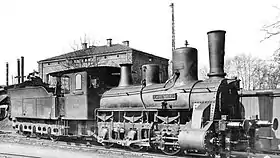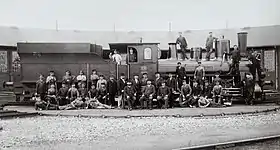Bavarian C III
The Bavarian C III engines were steam locomotives of the Royal Bavarian State Railways (Königlich Bayerische Staatsbahn).[1]
Standard variant
| Bavarian C III, standard variant | |
|---|---|
 C III Nr. 600 in Munich | |
| Number(s) |
|
| Quantity | 239 |
| Manufacturer | Maffei, Krauss |
| Year(s) of manufacture | 1868–1879 |
| Retired | by 1925 |
| Wheel arrangement | 0-6-0 |
| Axle arrangement | C n2 |
| Track gauge | 1,435 mm (4 ft 8 1⁄2 in) |
| Length over buffers | 14,115–14,300 mm (46 ft 3 3⁄4 in–46 ft 11 in) |
| Service weight | 34.5–38.0 t (34.0–37.4 long tons; 38.0–41.9 short tons) |
| Adhesive weight | 34.5–38.0 t (34.0–37.4 long tons; 38.0–41.9 short tons) |
| Axle load | 12.0–14.0 t (11.8–13.8 long tons; 13.2–15.4 short tons) |
| Top speed | 45 km/h (28 mph) |
| Driving wheel diameter | 1,253 or 1,274 mm (4 ft 1 3⁄8 in or 4 ft 2 1⁄8 in) |
| No. of cylinders | 2 |
| Cylinder bore | 468–508 mm (18 7⁄16–20 in) |
| Piston stroke | 660 mm (26 in) |
| Boiler Overpressure | 10 kgf/cm2 (981 kPa; 142 lbf/in2) |
| Grate area | 1.65 m2 (17.8 sq ft) |
| Evaporative heating area | 112.80–119.10 m2 (1,214.2–1,282.0 sq ft) |
| Tender | Bavarian 3 T 8.95/10,5 |
| Water capacity | 8.95 or 10.5 m3 (1,970 or 2,310 imp gal; 2,360 or 2,770 US gal) |
The standard variant of the C III was developed from the Class C II. A total of 239 examples were built, which varied somewhat in their dimensions. For example, the third batch had a boiler diameter 30 mm greater than the others. The vehicles taken over by the Reichsbahn were to have been given the numbers 53 7871–7990.[2] However these locomotives were retired by 1925. Several engines were sent to Belgium as reparations.
These engines were coupled with Bavarian 3 T 8.95 and 3 T 10.5 tenders.
Sigl variant
| Bavarian C III, Sigl variant | |
|---|---|
 C III Nr. 598, Sigl variant, in Simbach (Inn) | |
| Number(s) |
|
| Quantity | 14 |
| Manufacturer | Sigl |
| Year(s) of manufacture | 1872–1874 |
| Retired | to 1924 |
| Wheel arrangement | 0-6-0 |
| Axle arrangement | C n2 |
| Track gauge | 1,435 mm (4 ft 8 1⁄2 in) |
| Length over buffers | 14,890 mm (48 ft 10 1⁄4 in) |
| Service weight | 34.2–39.6 t (33.7–39.0 long tons; 37.7–43.7 short tons) |
| Adhesive weight | 34.2–39.6 t (33.7–39.0 long tons; 37.7–43.7 short tons) |
| Axle load | 11.4–13.2 t (11.2–13.0 long tons; 12.6–14.6 short tons) |
| Top speed | 45 km/h (28 mph) |
| Driving wheel diameter | 1,196 or 1,274 mm (3 ft 11 1⁄8 in or 4 ft 2 1⁄8 in) |
| No. of cylinders | 2 |
| Cylinder bore | 460 mm (18 1⁄8 in) |
| Piston stroke | 660 mm (26 in) |
| Boiler Overpressure | 8.5 or 10 kgf/cm2 (834 or 981 kPa; 121 or 142 lbf/in2) |
| Grate area | 1.59–1.84 m2 (17.1–19.8 sq ft) |
| Evaporative heating area | 114.80–114.30 m2 (1,235.7–1,230.3 sq ft) |
| Tender | Bavarian 3 T 12 |
| Water capacity | 12.0 m3 (2,600 imp gal; 3,200 US gal) |
These locomotives originally built for Hungary were acquired by the firm of Sigl, because new locomotives were urgently ordered for goods services. Following a subsequent exchange of the boiler they were identical with other vehicles of this class apart from their overall weight. The locomotives taken over by the Reichsbahn were to be given the numbers 53 7831–7833 but were retired by 1925.[3]
The vehicles were coupled with Bavarian 3 T 12 tenders.
References
- "Micro Metakit 06101H - Bavarian CIII Steam Locomotive". Reynaulds Euro Imports. Retrieved 2019-12-05.
- Mierzejewski, Alfred C. (2014-03-30). The Most Valuable Asset of the Reich: A History of the German National Railway. UNC Press Books. ISBN 978-1-4696-2020-6.
- "Baden State / Bavarian State 0-6-0 Locomotives in Germany". www.steamlocomotive.com. Retrieved 2019-12-05.